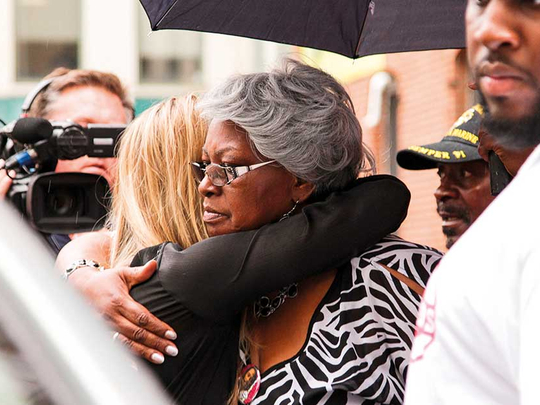
Cincinnati: The encounters with the police officers turned deadly within seconds. Each time, a black man was fatally shot, and each time, it was captured on video. And three times in the span of a week, the officers’ trials have ended without a conviction.
On Friday, it was a judge here who found that the jury was hopelessly deadlocked in the retrial of Raymond M. Tensing, the former University of Cincinnati police officer who faced charges of murder and voluntary manslaughter for fatally shooting Samuel DuBose, an unarmed motorist, in 2015. Tensing’s first trial, held last fall, also ended with a hung jury.
“We are almost evenly split regarding our final votes,” read the note passed from the jury to Judge Leslie Ghiz, who declared a mistrial as rain lashed against the windows of her chilly downtown courtroom. Tensing dropped his head into his hand and squeezed his eyes, while one man seated with DuBose’s family hung his head and looked out at the rain.
As she walked out of the courtroom, Terina DuBose-Allen, a sister of DuBose’s, spoke quietly: “I think it’s horrible.”
Jurors had deliberated for more than 30 hours in the case, which revolved around a botched traffic stop that prosecutors once called “asinine” and “senseless.”
The mistrial left prosecutors weighing whether to try Tensing a third time, and what charges to use if they do. Last week, after presenting their case, prosecutors had sought to add a third — and lesser — charge of reckless homicide to the jury’s options. Ghiz denied the motion, saying, in essence, that it was too late.
Joseph T. Deters, the head prosecutor in Hamilton County, said he would not comment on his plans until next week.
But DuBose’s family — along with activists gathered outside the courtroom — urged the prosecutors to press on.
“We are outraged that a second jury has now failed to convict Ray Tensing,” Audrey DuBose, Samuel DuBose’s mother, said in a statement. “We demand another retrial.”
In Cincinnati, prosecutors turned time and again to the body-camera footage gathered by Tensing when he stopped DuBose on a summer evening after noticing a missing licence plate. Tensing asked DuBose for his driver’s licence, which he never produced. In a split second, the video turned violent, and the footage shaky: DuBose pulled the door closed with his left hand and restarted the car with his right hand; Tensing reached into the car with his left arm, yelled “Stop!” twice and with his right hand fired his gun once, into DuBose’s head.
“You point a gun that close to somebody’s head and you pull the trigger, your purpose is to end their life,” a prosecutor, Seth Tieger, said in his closing argument Monday, as he described the video as a crucial piece of evidence.
But the footage was jerky and blurred, and prosecutors had to slow it down, with the aid of a forensic expert, in their effort to counter Tensing’s contention that his arm had felt stuck in the steering wheel and that he had shot DuBose because he believed he was going to be dragged by the car.
“There was no danger to Ray Tensing when he made the decision to go for his gun,” Tieger said.
Indeed, the video had contradicted Tensing’s initial claim that his arm had been caught in the steering wheel. But Tensing’s lawyer, Stew Mathews, said that the analysis of the video amounted to “20/20 hindsight,” and that what mattered was Tensing’s stated belief, in the moment, that DuBose was a danger to him and that he had to shoot to “stop the threat.”
“The body-worn camera, in and of itself, is not the only piece of evidence,” Mathews said, before appearing to shift the blame to DuBose himself, saying that he had “started this whole situation.”
“You have to try to put yourself into the position of an officer on the scene of a situation like this,” Mathews told the jury, “and ask yourselves, ‘What would I do?’”
The jurors may have come to their conclusions less because of what they saw on screen than because of what they believed was in Tensing’s mind in those critical seconds.
“I suspect that the more ambiguous a video is, the more that you need a forensic expert to explain a jury exactly what it shows, the more likely a jury is to think the officer’s perception was reasonable,” said Seth W. Stoughton, a law professor at the University of South Carolina and a former police officer.
Stoughton described a possible juror’s reasoning: “If I needed an expert to explain that to me, how could the officer have made sense of the situation at the time?”
Tensing, who was 25 at the time of the shooting, was fired by the University of Cincinnati after being indicted on a murder charge for killing DuBose, 43. The university also agreed to pay DuBose’s family $4.85 million and to educate his 12 children.












